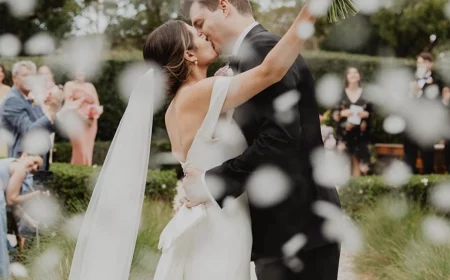The Real-Talk Guide to a Backyard Wedding That’s Actually Amazing
After planning countless events in every setting imaginable, from fancy ballrooms to rustic barns, I can tell you this: some of the most incredible celebrations happen right in a family’s backyard. There’s a warmth and personality you just can’t replicate anywhere else. It’s deeply personal.
In this article
But let’s be real. That beautiful intimacy comes with a whole host of challenges. A backyard isn’t a professional venue, and it’s missing all the infrastructure we usually take for granted. So many people assume a backyard wedding is the simpler, cheaper route. It can be, but only if you plan for it smartly. Otherwise, you’re not just throwing a party—you’re building a full-service venue from the ground up for one single day.
This isn’t a guide about choosing color schemes or flower types. This is the field guide, full of the nitty-gritty lessons learned from experience. We’re talking technical details, safety checks, and logistical puzzles that turn a patch of grass into a safe, comfortable, and truly magical place. Let’s walk through it like the pros do.
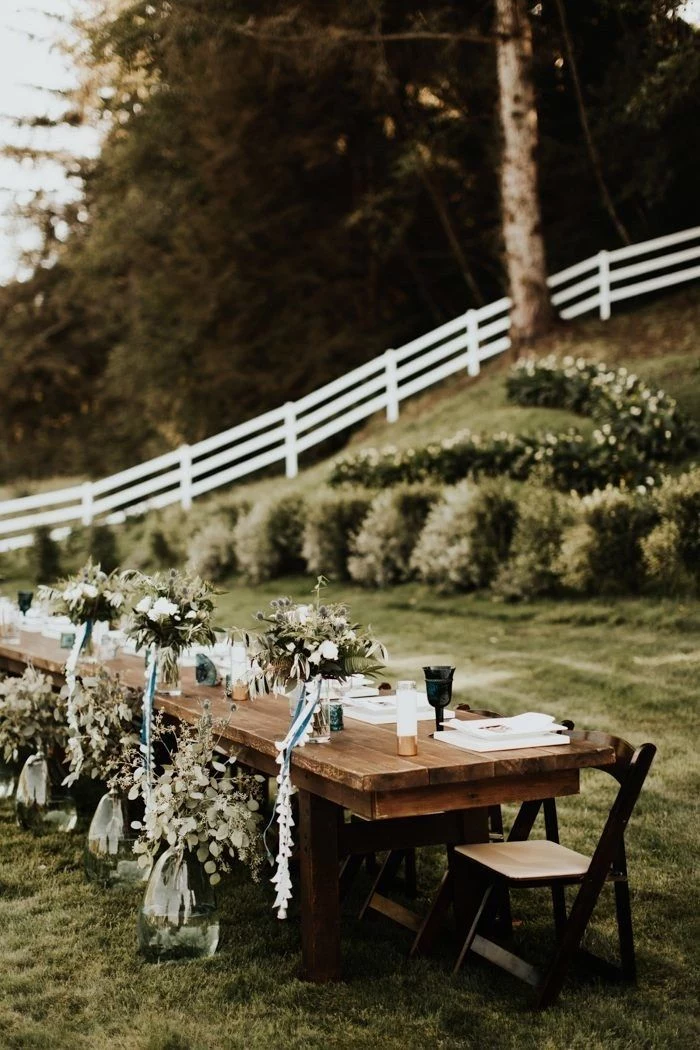
First Things First: A Realistic Site Check
Before you even think about renting a single fork, you need to understand your space on a deep level. A planner doesn’t just see a lawn; we see a landscape with potential and problems. This first step is a detailed analysis that will save you massive headaches later on.
Map Your Territory
Grab a measuring tape, a notepad, and get to work sketching the property. Mark down the house, big trees, flowerbeds, sheds—anything permanent. Then, you need to get to know the ground itself. Is it perfectly flat or does it have a subtle slope? A slight grade can make tables wobble and chairs feel unstable. It also tells you exactly where water will pool if a surprise shower hits. Poke the ground. Is it soft soil where heels will sink? Or is it firm? This one detail will determine whether you absolutely need to rent flooring.
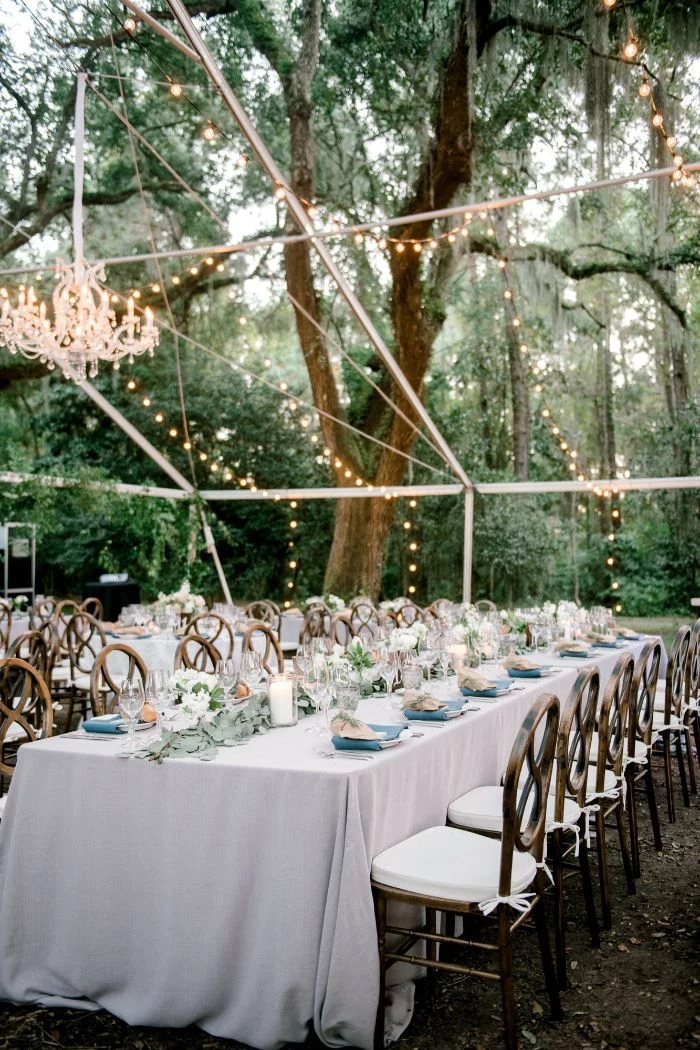
Next up: become a sun-stalker. Visit the yard at the exact time of day you’re planning your ceremony and reception. Where is the sun blazing? Where is the shade? That gorgeous spot under the oak tree might be perfect, but not if it’s in direct, scorching sun at 4 PM. This little bit of observation is key for guest comfort.
The Power Grid You Don’t See
Honestly, this is the single most overlooked part of a backyard wedding. Your home’s electrical system was not built to power a party. A catering team might need two or three separate 20-amp circuits just for their warming ovens and coffee machines. The DJ needs juice for speakers and lights. Add your own pretty string lights, and you’re begging for a tripped breaker that plunges the entire reception into darkness. I’ve seen it happen. It’s a total party killer.
Here’s what you do. Ask your caterer and DJ for their ‘power drops’ or ‘spec sheet.’ Add up the amps they need. A caterer might request two 20-amp circuits, the band needs one, and your lights need another. That’s four dedicated circuits your house probably can’t spare. This is exactly why a quiet generator rental is your best friend. Expect to pay between $400 and $900 for a reliable one. It gives you a separate, dedicated power source that won’t cause a blackout in your kitchen.
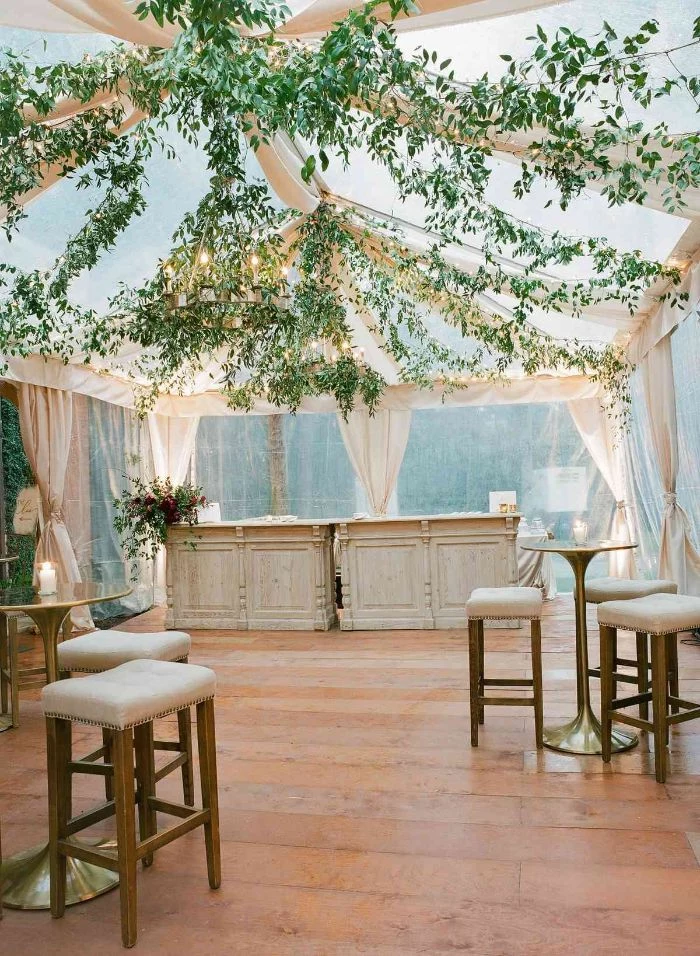
And this part is non-negotiable: you have to locate your underground utilities. If you’re using a tent that needs to be staked into the ground, you MUST know what’s buried there. Hitting a water pipe or gas line is not just expensive, it’s incredibly dangerous. In the U.S., you can call 811 (the “call before you dig” hotline) and they’ll send someone to mark public utility lines for free. A friend of mine once saw a client almost drive a tent stake straight through a sprinkler line. That free 5-minute call saved them from flooding their own reception.
Building Your Venue: Tents, Flooring, and Flow
Once you know your site, you can start building the temporary “rooms” for your event. This is where you physically create the ceremony spot, the dining area, and the dance floor.
Let’s Talk Tents
A tent is so much more than a rain plan. It creates shade, defines the reception space, and gives you something to hang lights and decor from. You’ve basically got two main options, and they serve different purposes.
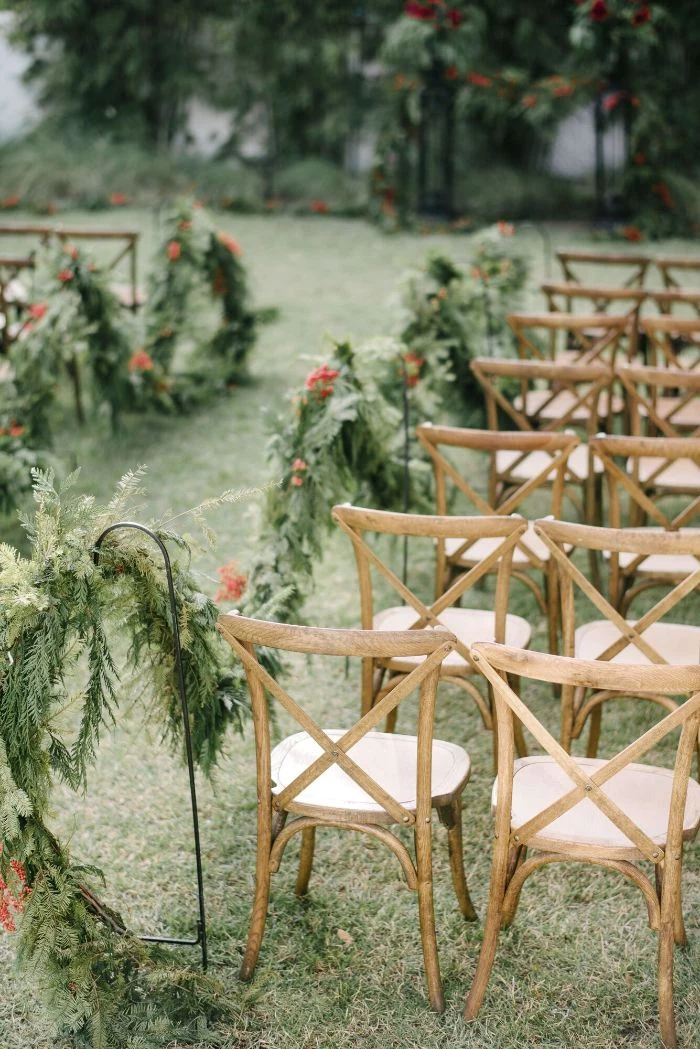
First is the pole tent. This is the classic, romantic-looking tent with high, swooping peaks. It’s held up by center poles and a whole network of ropes and stakes. They’re beautiful but require a big, clear, grassy area you can drive a lot of stakes into. The poles inside can also make laying out tables a bit of a puzzle.
Your other main choice is a frame tent. This is a freestanding structure with a sturdy metal frame, meaning no poles in the middle of your dance floor. These are way more versatile. They can go on grass, patios, or even driveways, and they can be weighed down with heavy concrete blocks instead of stakes. This makes them the go-to for more complex backyards. When you talk to a rental company, ask about the wind rating. A professionally installed tent is a safety investment—it’s engineered to handle bad weather.
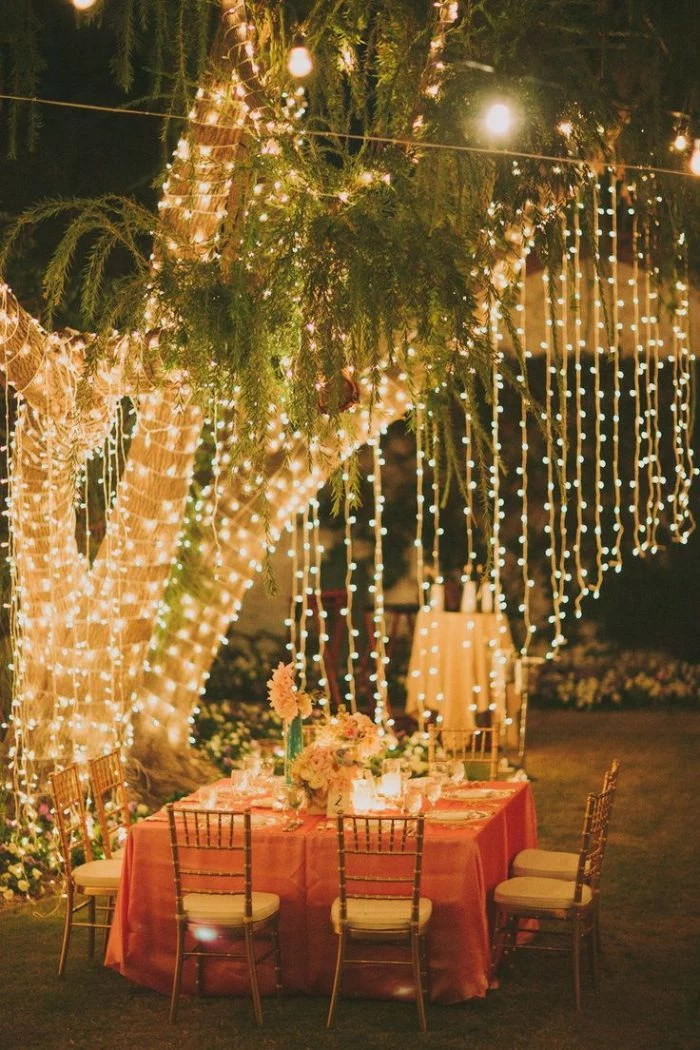
A tent rental can be one of your biggest costs, ranging anywhere from $1,500 to over $10,000 depending on the size, style, and whether you add walls or liners.
Why Flooring Matters
Flooring often feels like an optional upgrade, but it’s incredibly practical. It protects your lawn from getting destroyed, and more importantly, it creates a level, stable surface for your guests. Nobody wants to sit at a wobbly table or have their chair slowly sink into the mud. A solid dance floor is also a safety issue—dancing on uneven grass is a twisted ankle waiting to happen. You can rent a simple dance floor for $500-$1,500, or go for full flooring under the tent, which can cost $2-$4 per square foot but is worth every penny if rain is a possibility.
Setting the Mood: Lighting and Sound
This is the fun part. The right lighting and sound are what transform a regular backyard into a magical event space. It’s all about blending function and feeling.
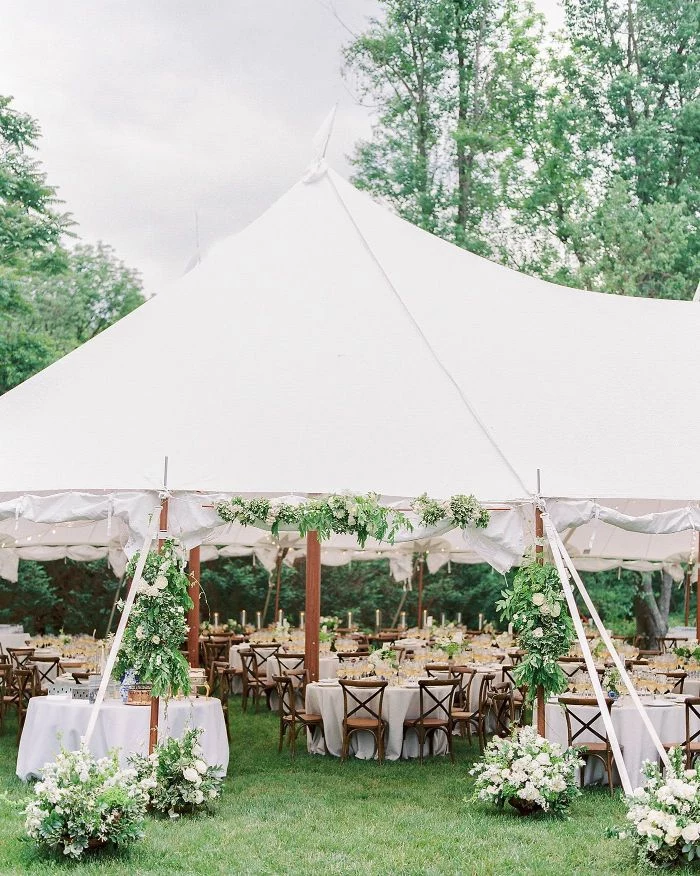
Good lighting design is layered. Start with ambient light—think warm, glowing string lights (bistro lights) crisscrossing over the tables. Next is task lighting, which is focused light for key areas like the bar, food stations, or cake table. Finally, you have accent lighting. Use this to uplight a gorgeous tree or a stone wall, creating a stunning visual backdrop. Quick tip: use only heavy-duty, outdoor-rated extension cords and tape them down with gaffer’s tape (the matte fabric kind, not shiny duct tape) to prevent trips.
Sound is also tricky outdoors. A common mistake is just putting two huge speakers by the DJ, which blasts the dancers but leaves people in the back unable to hear. A pro move is to use several smaller speakers placed around the perimeter. This creates a more even, comfortable volume for everyone. And please, be a good neighbor. Pop over a week before the wedding to let them know your plans. Check your local noise ordinances, which often require you to lower the music after 10 or 11 PM.

The Guest Experience: Keeping People Happy
Your guests’ comfort is everything. In a backyard, you have to anticipate their needs from start to finish.
The Restroom Reality Check
We have to talk about bathrooms. Your home’s plumbing is not designed for 100+ guests. The lines will be long and you’re risking a major plumbing disaster. The solution is a luxury restroom trailer. These aren’t your typical plastic port-a-potties; they are climate-controlled, have flushing toilets, running water sinks, and nice lighting.
Good to know: a solid rule of thumb is to plan for one stall for every 35-50 guests. A nice trailer will likely run you $800 to $2,500, but it is one of the most important investments for guest comfort. Trust me.
Be Ready for the Weather
Think about your local climate. If you’re in a hot, humid area, rent large cooling fans or even a portable AC unit for the tent. Having the yard professionally sprayed for mosquitos a few days prior is also a game-changer. For cooler climates, propane patio heaters are a must for the evening. You can rent them for about $75-$100 each. A basket of cozy blankets is a thoughtful touch guests always appreciate.
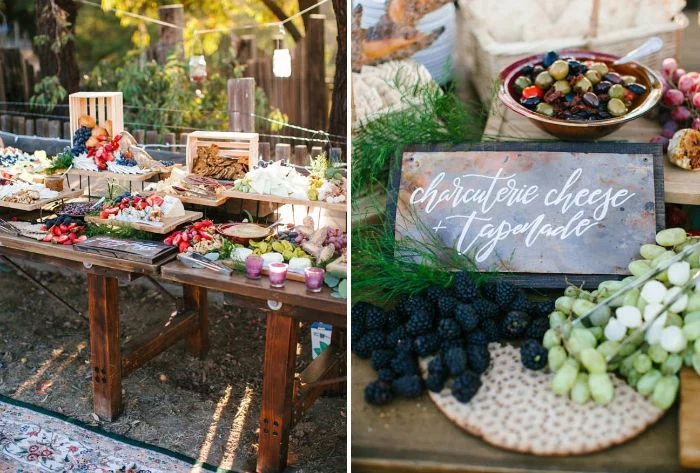
The Food Situation
A professional caterer can’t work out of your home kitchen; it’s a recipe for chaos. The standard is to set up a dedicated catering tent, usually tucked away behind the main tent. This area needs power, tables, and water access. The caterer will also manage food safety, ensuring everything is kept at the proper temperature. This is a huge health and safety responsibility that a pro team handles seamlessly.
The Non-Negotiables: Permits, Insurance, and a Coordinator
This is the serious but essential stuff. When you host an event at home, you take on significant responsibility. Don’t cut corners here.
First, call your local city or county office. Many towns require permits for large tents or have strict fire codes and noise ordinances. Ignoring this can lead to fines or, even worse, getting your event shut down.
Next, call your homeowner’s insurance agent. Your standard policy likely won’t cover a large-scale event. You’ll need to purchase a separate one-day event liability policy. It’s also standard practice to require your major vendors (caterer, rentals) to provide you with a certificate of insurance. If you feel awkward asking, just send a simple, professional email:
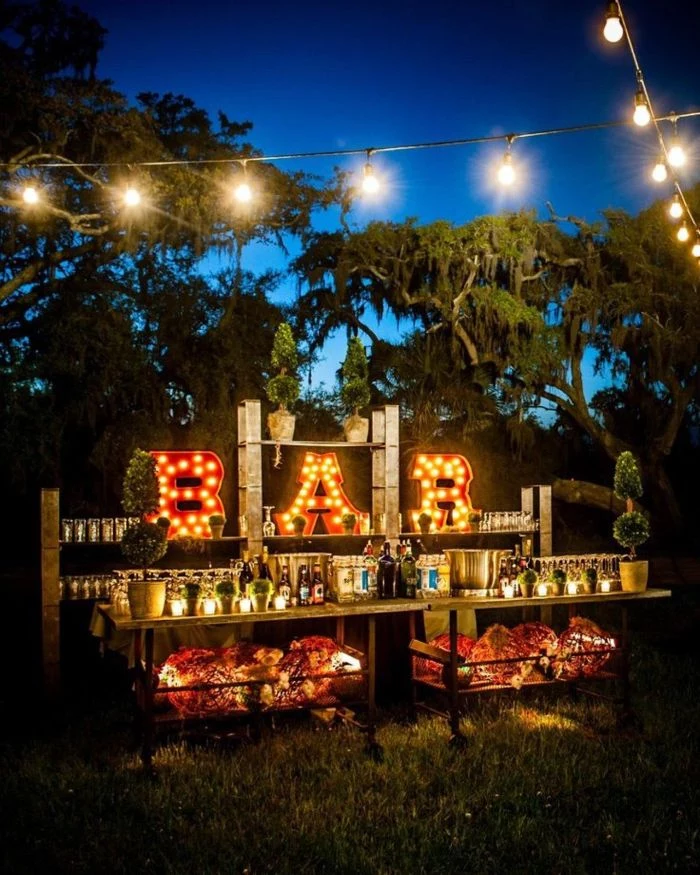
“Hi [Vendor], as we finalize details, our insurance advisor has asked for a certificate of insurance naming us as additional insured for the day of the event. Could you please send that over when you have a moment? Thanks so much!”
Finally, and I can’t say this enough, hire a day-of coordinator. Even if you plan everything yourself, you do not want to be the person troubleshooting a generator or directing a lost vendor on your wedding day. A coordinator is the point person for everyone, solving problems so you can actually be a guest at your own party. It’s the best money you’ll spend on your own peace of mind, period.
Inspirational Gallery
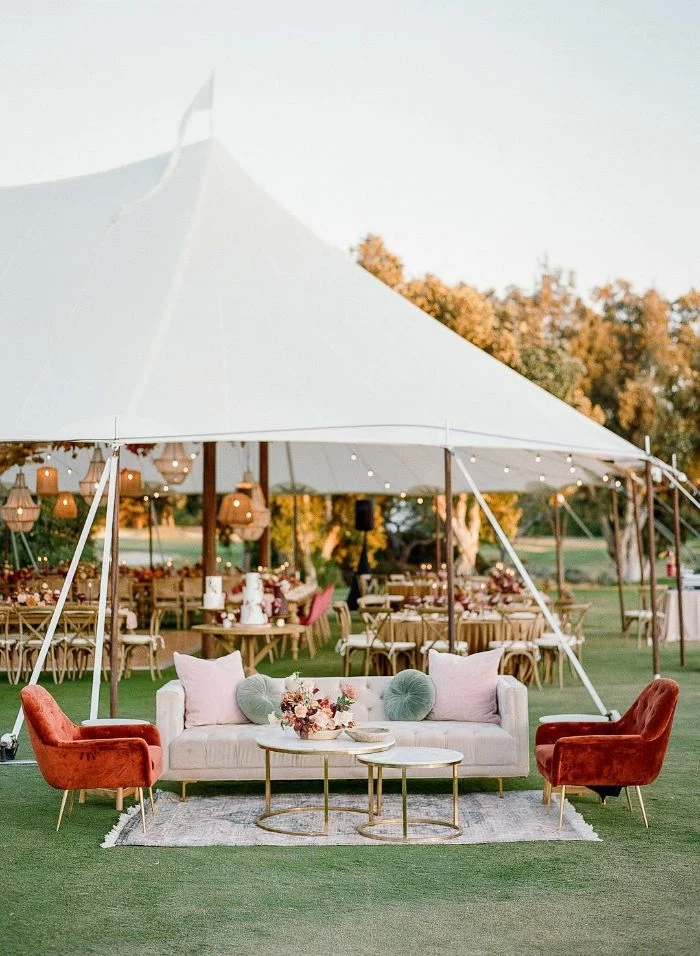
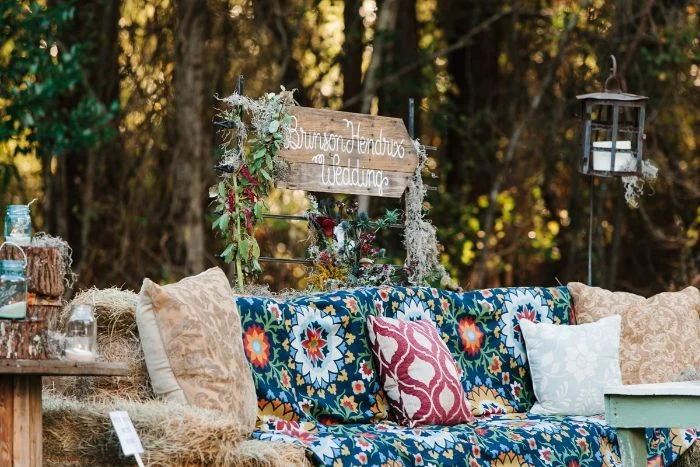
Don’t just think about lights; think about power. A standard home electrical system is not built to handle catering ovens, a DJ’s sound system, and hundreds of feet of string lights. You will almost certainly need to rent a silent generator. A professional rental company like United Rentals can assess your needs and provide a quiet, fume-free model that won’t disrupt the vows.
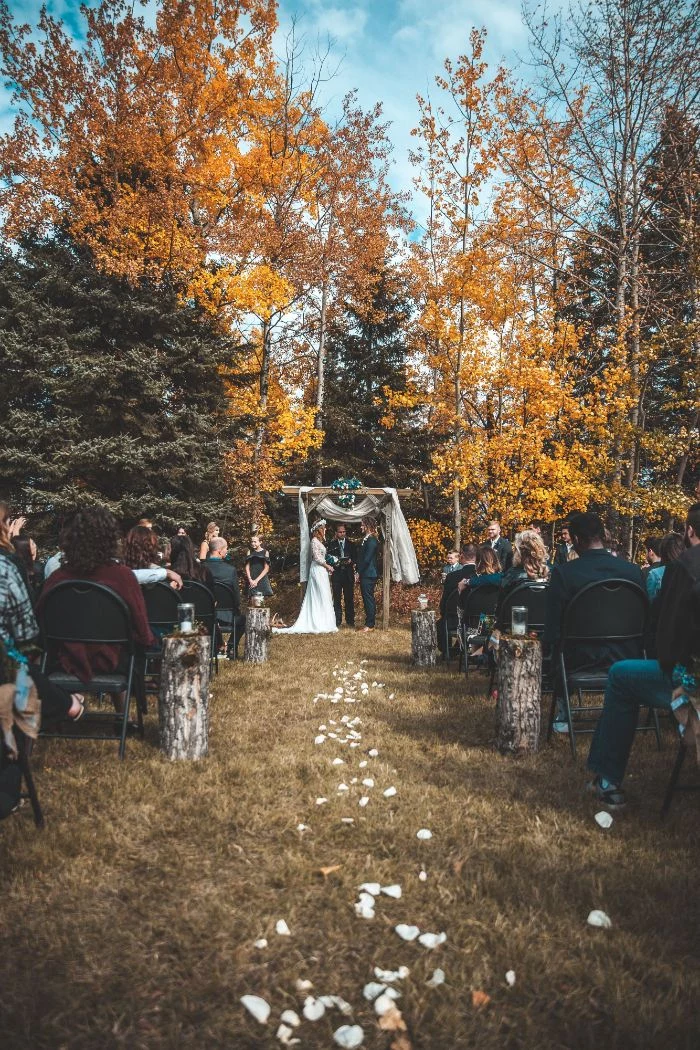
- A basket of pashminas or simple fleece blankets for when the sun goes down.
- A well-stocked ‘comfort station’ with bug spray, sunscreen, and heel protectors for soft grass.
- Charging stations for phones, tucked away near the lounge area.
- Paper fans for a warm afternoon ceremony.
The secret to happy guests? Anticipating their small comforts.
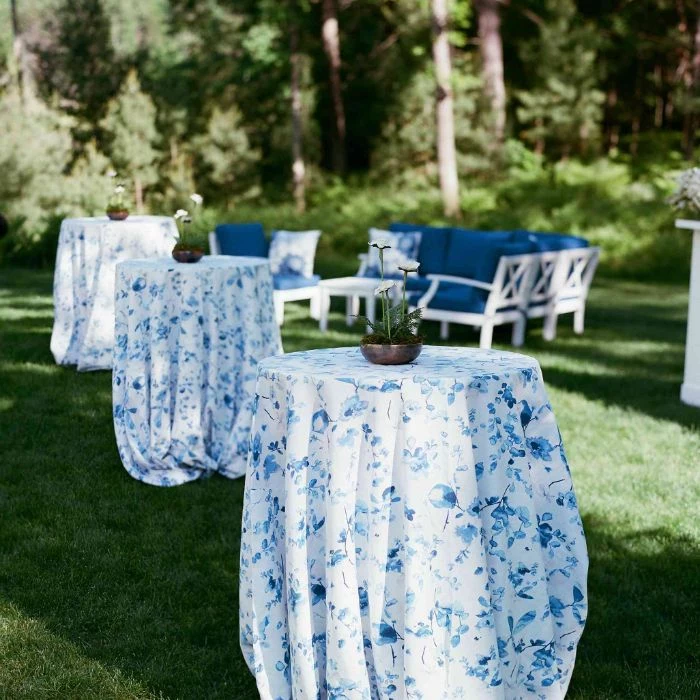
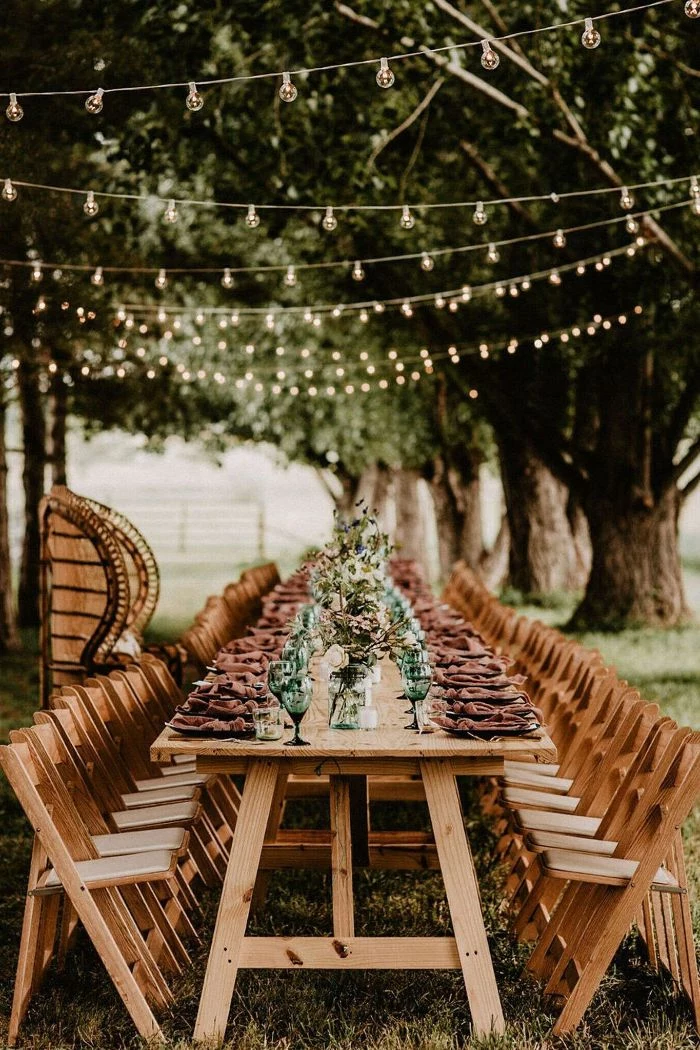
What happens if a guest trips on a tent stake or has an allergic reaction to a bee sting?
Your standard homeowner’s policy will not cover this. You absolutely must secure one-day event liability insurance. Many policies also offer cancellation coverage, which can be a lifesaver if a freak storm makes the event impossible. Companies like WedSafe or The Event Helper specialize in this and it’s a non-negotiable part of your budget.

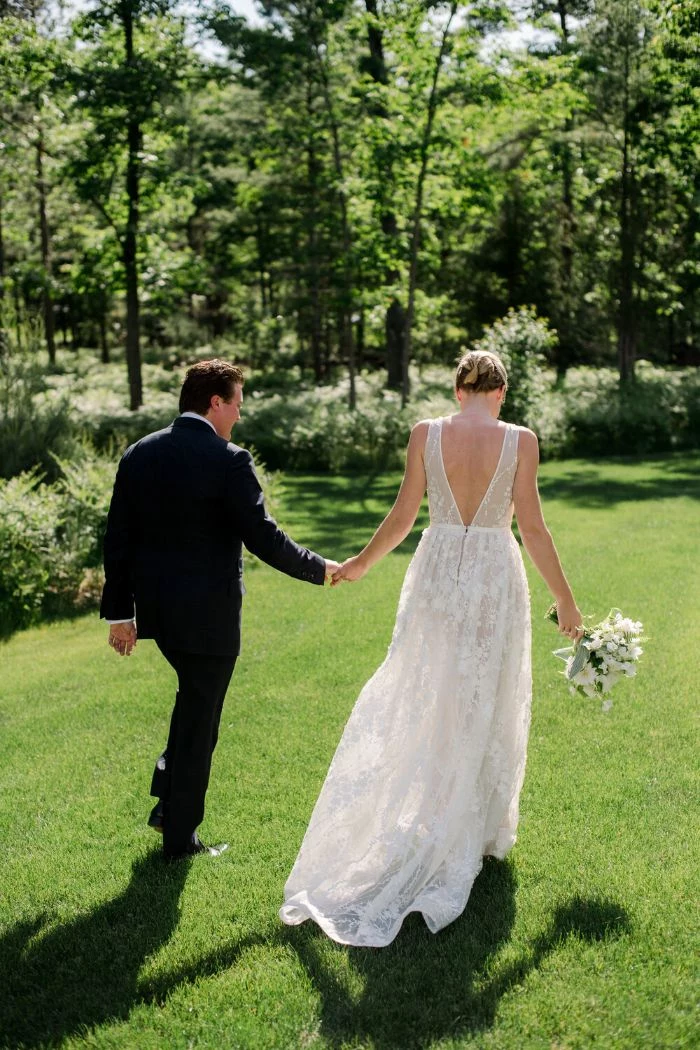
The industry standard is one portable restroom for every 35 guests to keep lines manageable.
And don’t just order the basic construction-site model. Look for ‘luxury restroom trailers.’ These units come with flushing toilets, running water sinks, mirrors, and even air conditioning. It’s one of the single most important upgrades for guest comfort.
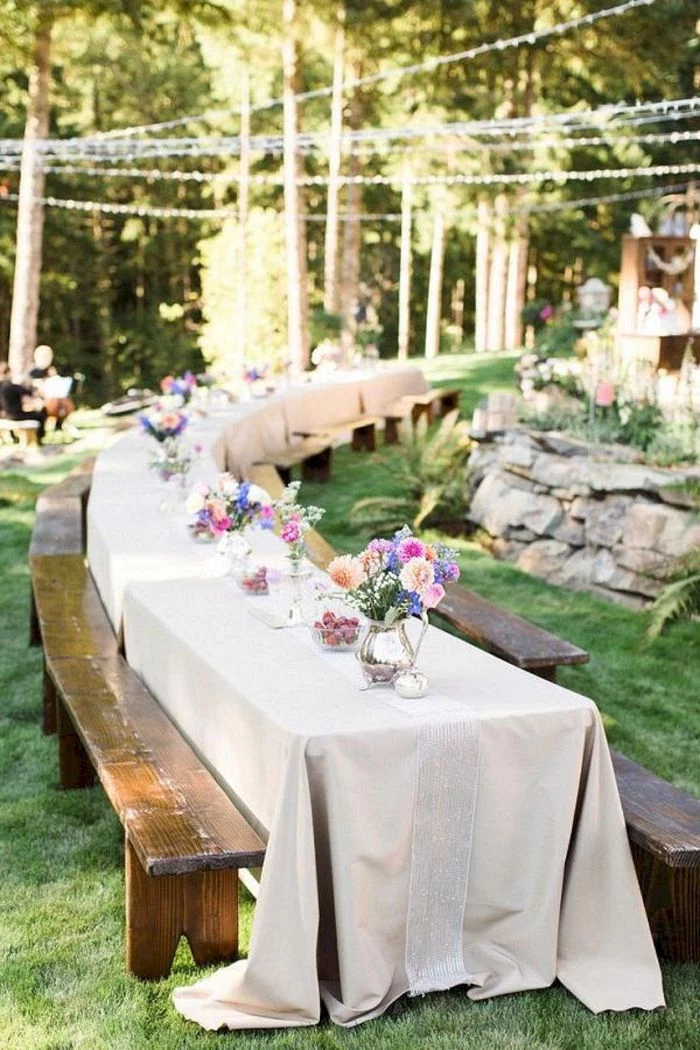
Pole Tent: Known for its elegant swooping peaks, it creates a classic, romantic feel. Requires staking directly into the ground, so it’s not suitable for patios or driveways.
Frame Tent: A freestanding structure with no interior poles, offering maximum usable space inside. Can be weighted down, making it perfect for setup on asphalt or concrete.
For a classic grassy meadow look, the aesthetic of a Sperry Tent (a type of pole tent) is unmatched. For practicality on mixed surfaces, a frame tent is the safer bet.
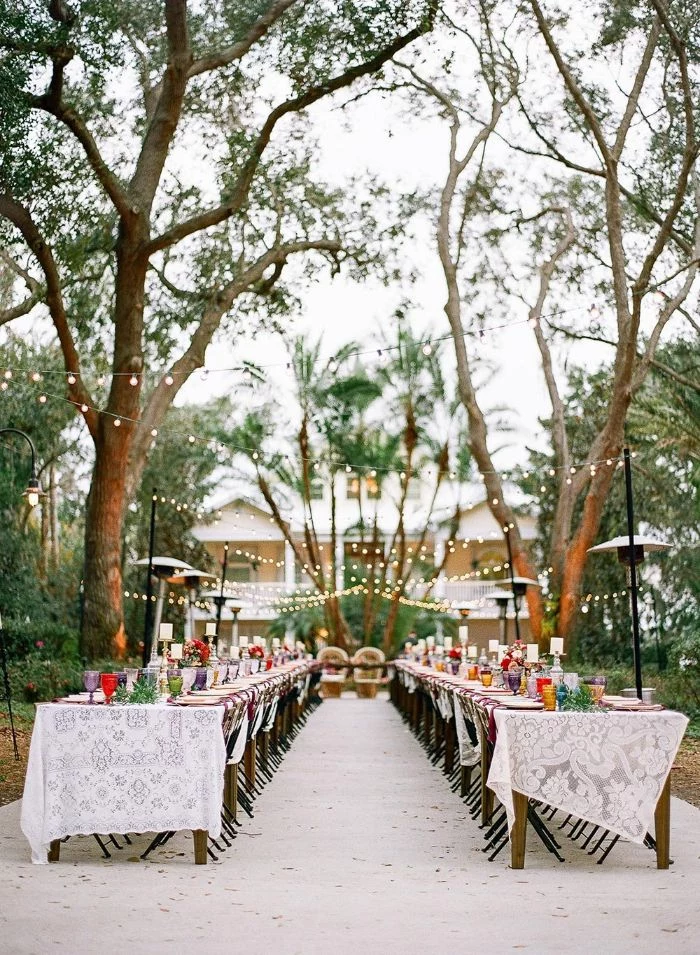
Lighting is more than just visibility; it’s the soul of the evening’s atmosphere. Go beyond the overhead bistro lights to create depth and magic.
- Uplighting: Place lights at the base of large, beautiful trees to turn them into dramatic natural sculptures.
- Path Lighting: Use small, low-level stakes or lanterns to guide guests safely from the parking area to the restrooms and between different zones.
- Pin Spotting: Use narrow beams of light to highlight the cake table or the floral centerpieces, making them pop in the darkness.
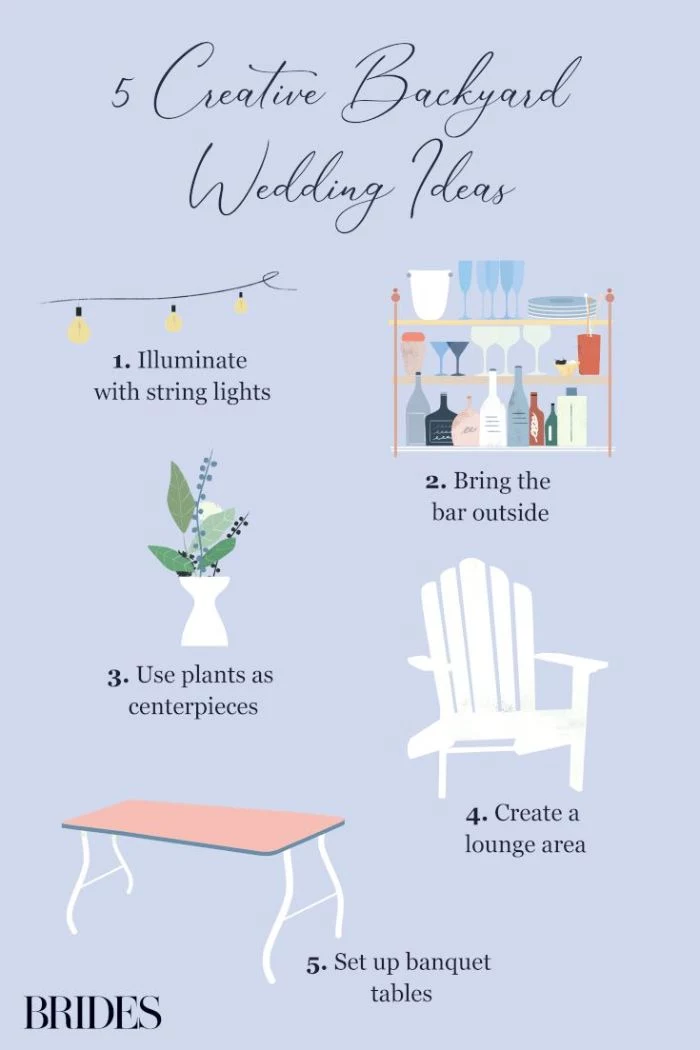
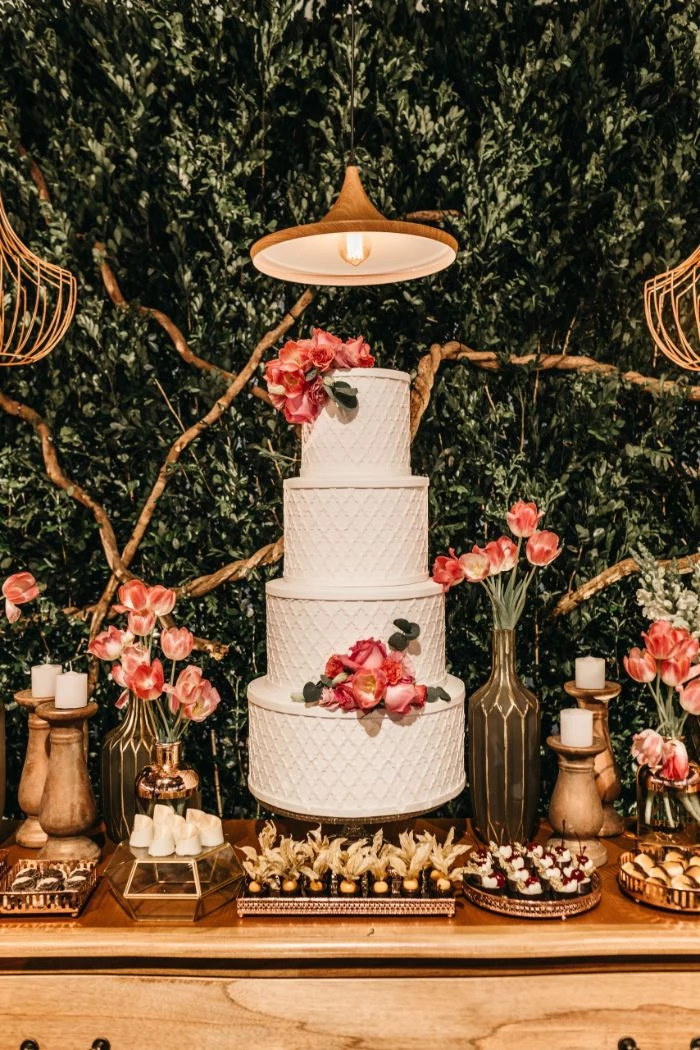
Crucial conversation: Weeks before the event, take a bottle of wine or a small gift to your immediate neighbors. Show them your plan, give them a schedule (especially for sound checks and music end times), and provide a contact number for the day-of in case of any issues. This small gesture can prevent a noise complaint that shuts your party down early.
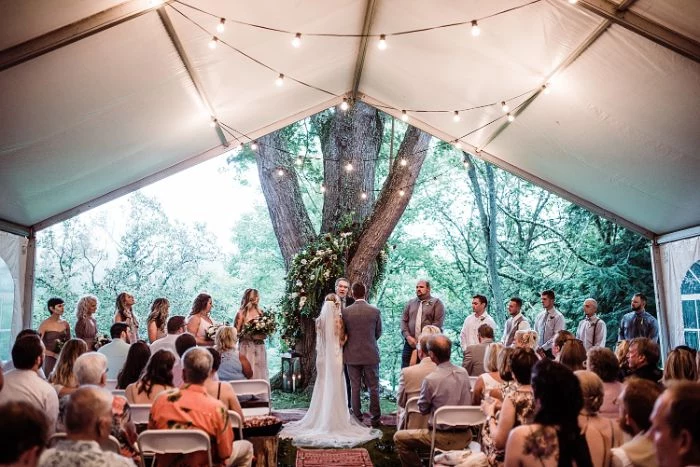
- Guests can see the food being prepared, adding a dynamic, interactive element.
- It keeps all the heat, smoke, and mess of cooking far away from the main party area.
- It provides a professional, sanitary space for the chefs to work their magic.
The secret? A dedicated catering tent. This ‘back of house’ area, complete with its own flooring, lighting, and water source, is the engine room of a seamless backyard wedding meal.
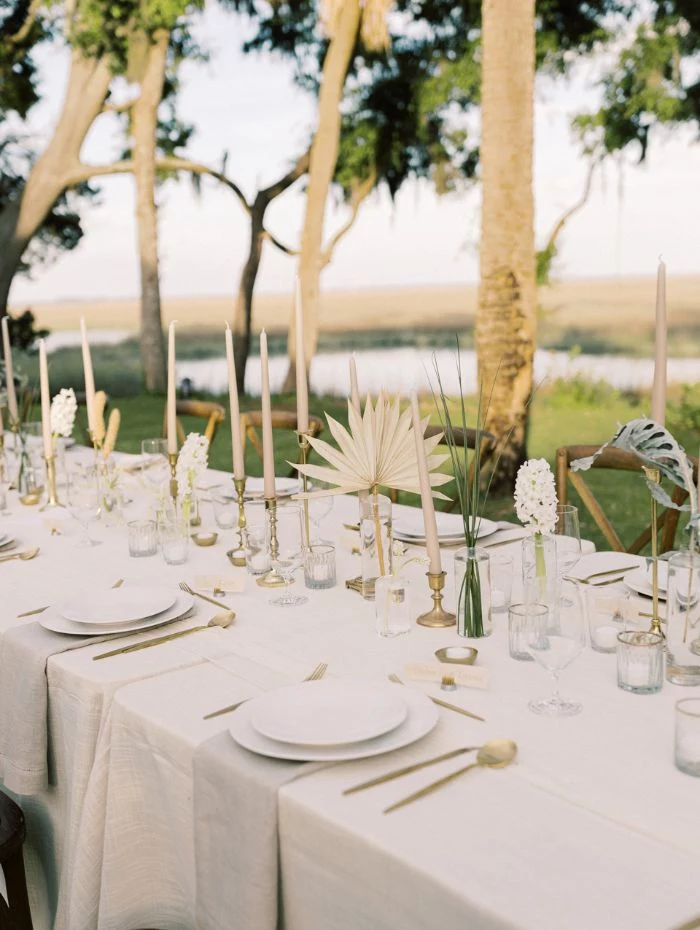
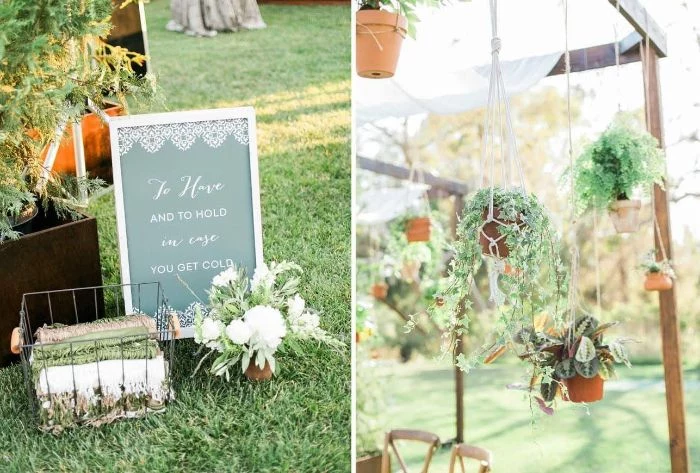
Many municipalities have noise ordinances that go into effect as early as 10 PM, even on weekends.
This doesn’t just mean your 12-piece band has to stop. It can apply to any amplified sound, including a DJ’s playlist. Check your local town or county regulations before you plan a reception that rages until 2 AM. The solution might be an ‘after-party’ indoors or a silent disco where guests use headphones.
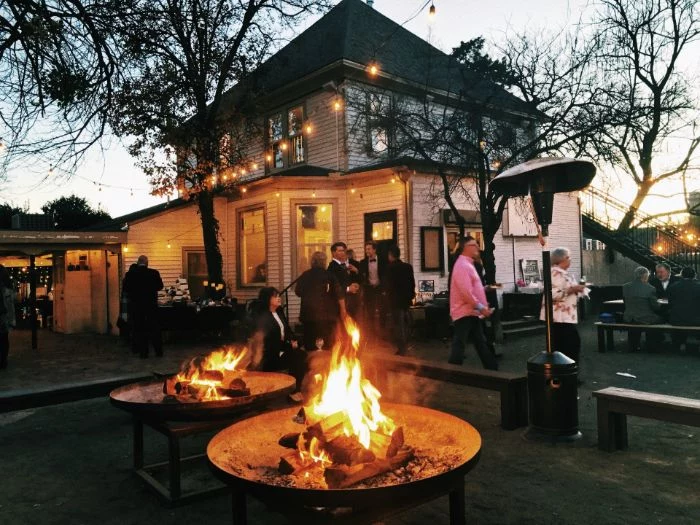
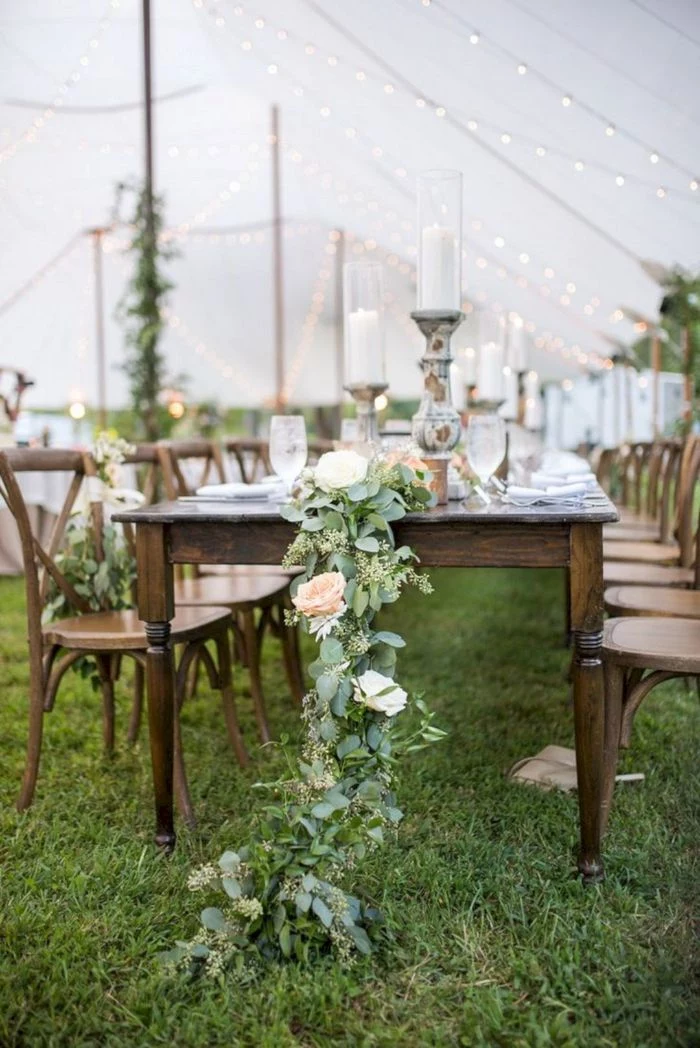
Don’t let mosquitoes be the most memorable guests at your wedding. A few days before the event, have a professional pest control service spray the area with a party-safe, eco-friendly solution. It’s a small investment that pays huge dividends in comfort, especially for an evening reception near water or woods.

Will our wedding photos look… like they were taken in our backyard?
A skilled photographer sees it differently. They’ll use the familiar spots in new ways: the dappled light through a favorite oak tree at golden hour, the texture of an old stone wall as a backdrop, or a dramatic portrait on the porch where you’ve had a million morning coffees. The personal history of the space adds a layer of emotion that a generic venue can’t match.
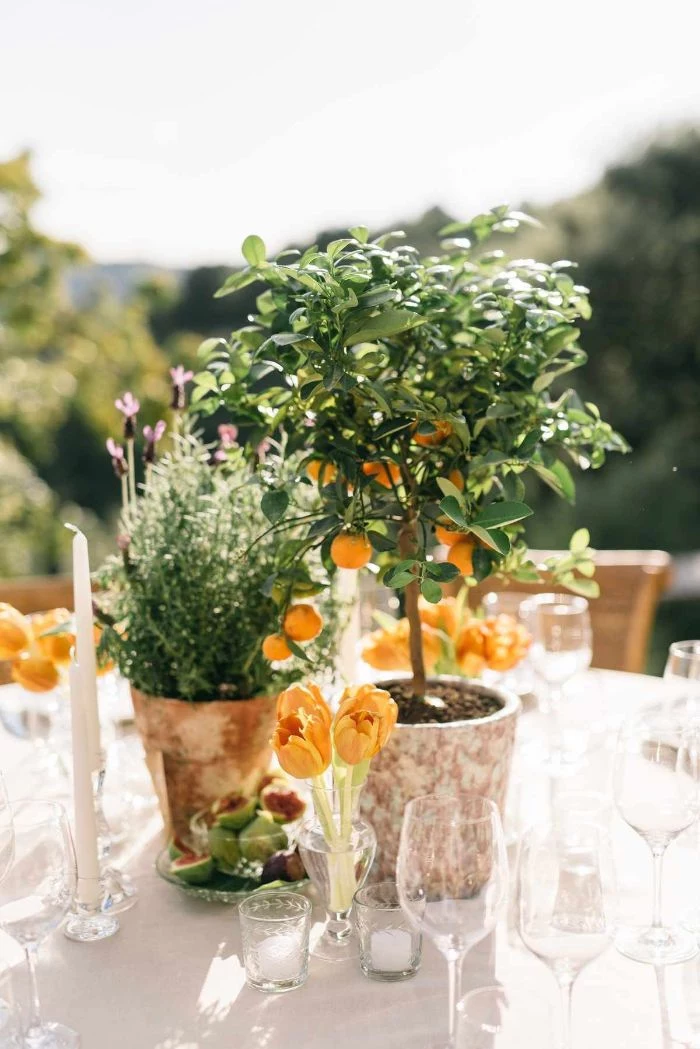
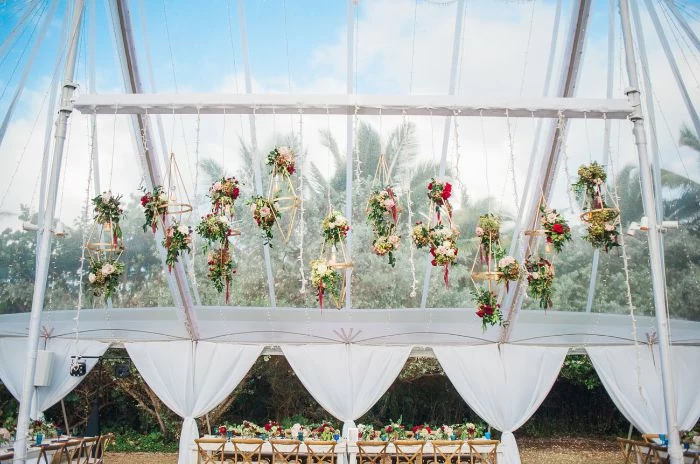
Think of your yard as a blank canvas and create distinct ‘rooms’ to guide the flow of the party. Use furniture, rugs, and lighting to define zones:
- A low-seating lounge area with outdoor sofas for cocktail hour.
- A designated dining space under a tent or the stars.
- A clear, hard-surfaced dance floor area.
- A separate, quieter corner for conversation, perhaps around a fire pit.
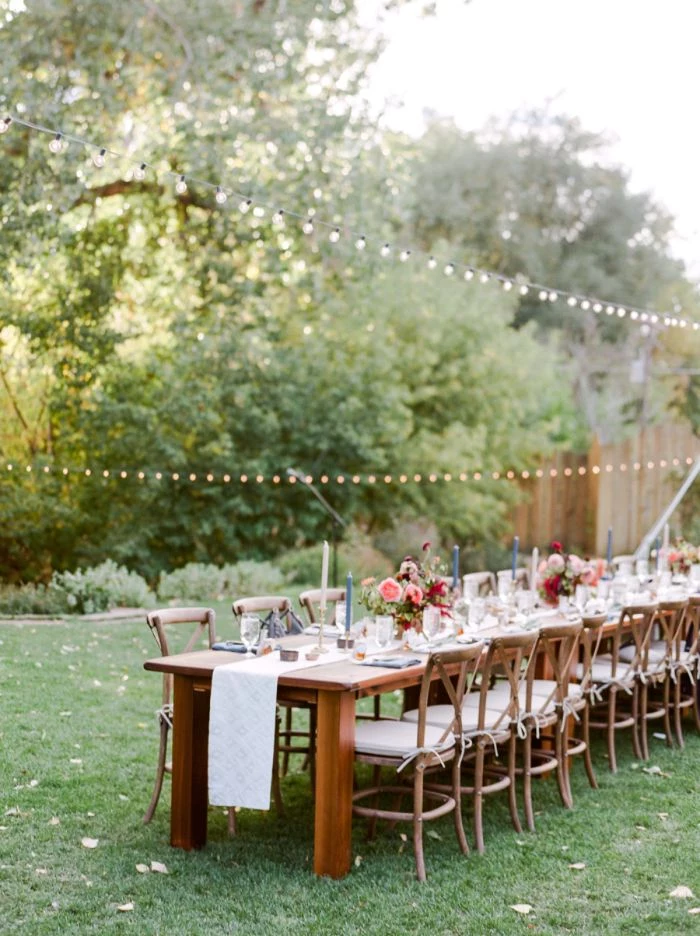
A food truck can be a fun, casual catering alternative, but it’s not as simple as having one pull up to the curb. You’ll need to confirm they have a completely flat, level spot to park, and you must know their specific power requirements. Most will need to connect to your rented generator, not a simple house outlet.
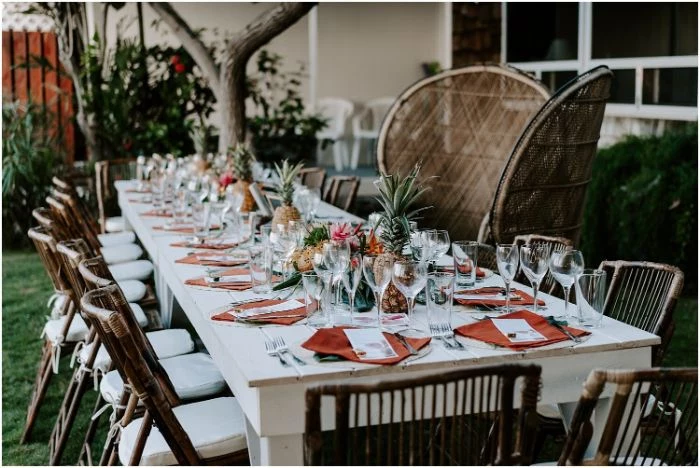
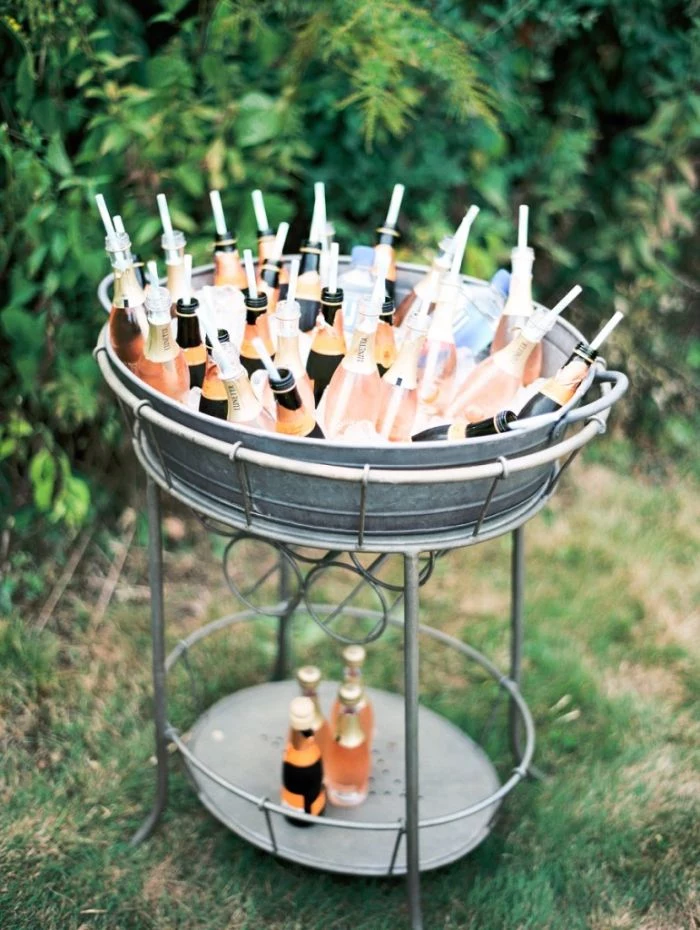
Dance Floor Only: A simple 15×15 foot wood-look vinyl dance floor is a must if you want dancing on grass. It provides a stable, safe surface and defines the party space.
Full Tent Flooring: A much larger expense, this involves laying down a subfloor over the entire grassy area under the tent. It’s essential if the ground is uneven, soft, or if rain is a serious possibility.
If the ground is firm and level, save the money and opt for just the dance floor. If there’s any doubt, full flooring is a wedding-day-saver.
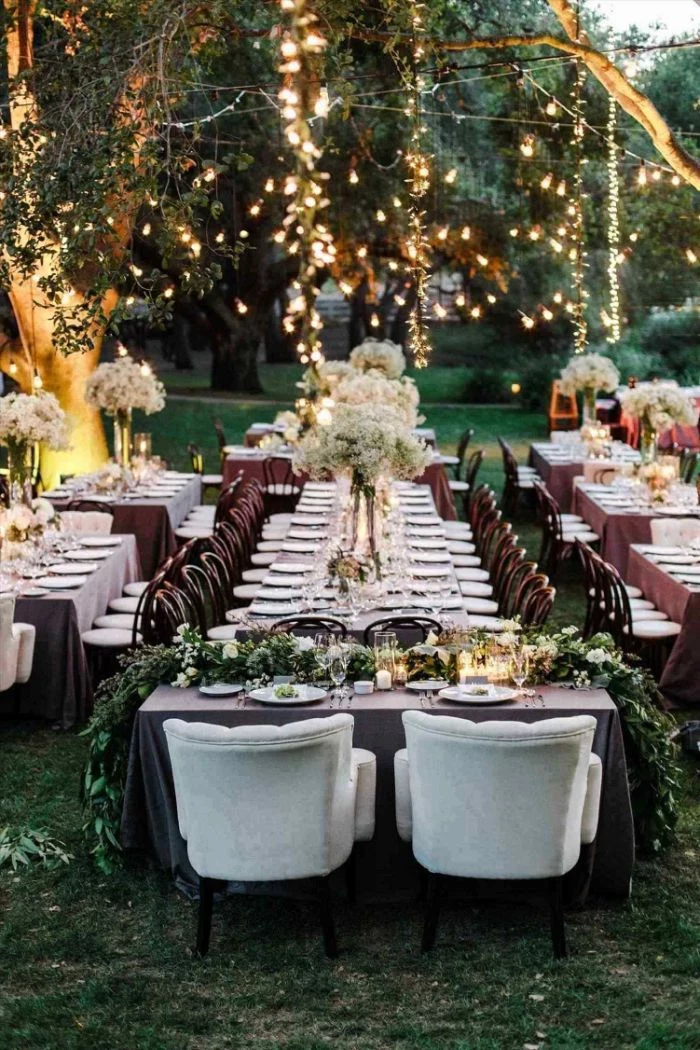
Unless you live on a farm with acres of fields, guest parking is a major logistical puzzle. Forcing 100+ guests to find street parking in a residential neighborhood is a recipe for disaster. The professional solution is to arrange parking at a nearby school or church lot and hire a shuttle bus or valet service. It’s an added cost, but it’s essential for a smooth guest experience.
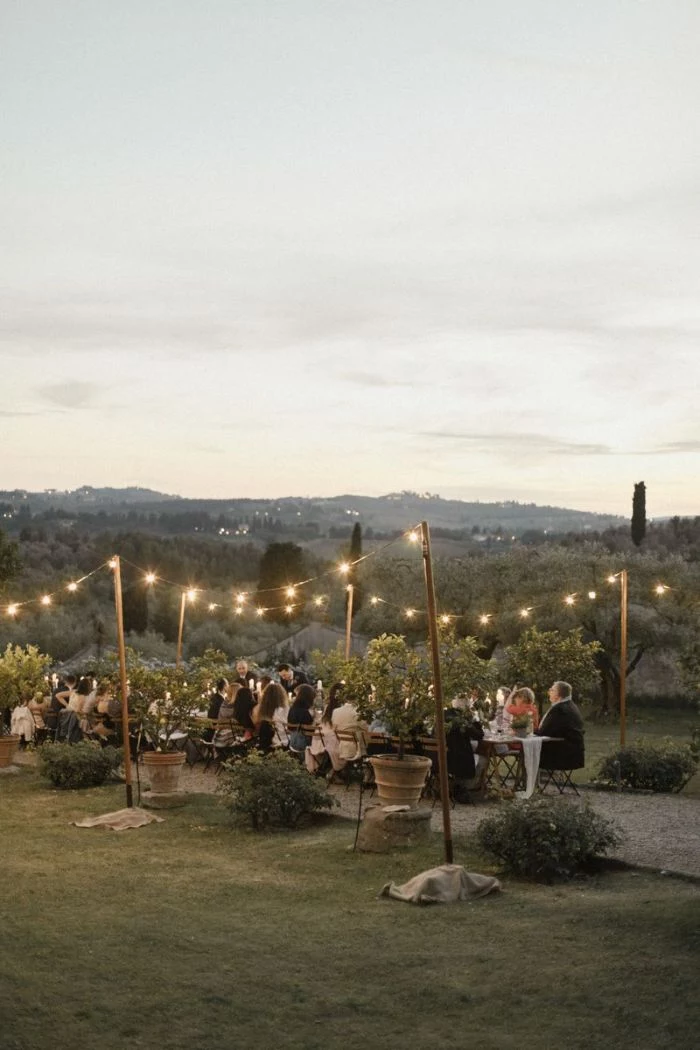
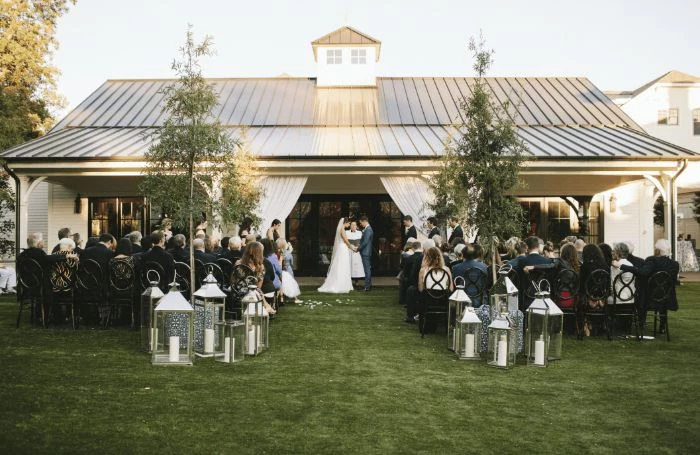
Don’t forget the signage! In an unconventional space, clear and beautiful signs are functional art. You’ll need elegant, coordinated signs for:
- Parking / Shuttle Stop
- Welcome & Order of Events
- Restrooms
- Bar & Signature Drinks
- Guest Book / Gift Table
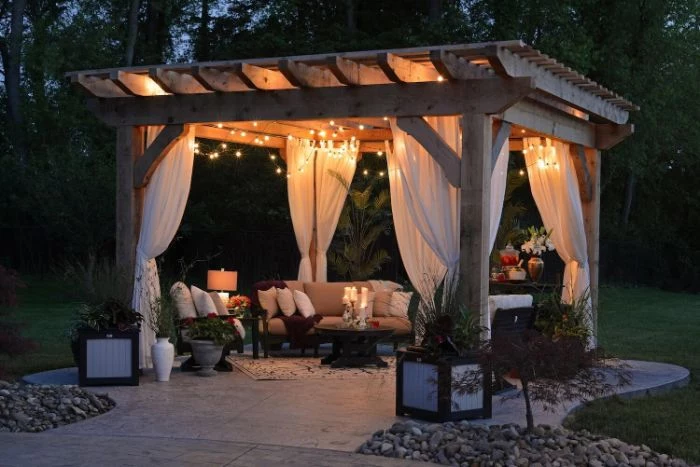
The Challenge: Your home is both the sentimental backdrop and the functional staging area. Staff will be walking through the kitchen, a bathroom might be used for touch-ups, and a spare room becomes the couple’s private holding area. Be prepared to cede control of your personal space for 24 hours.
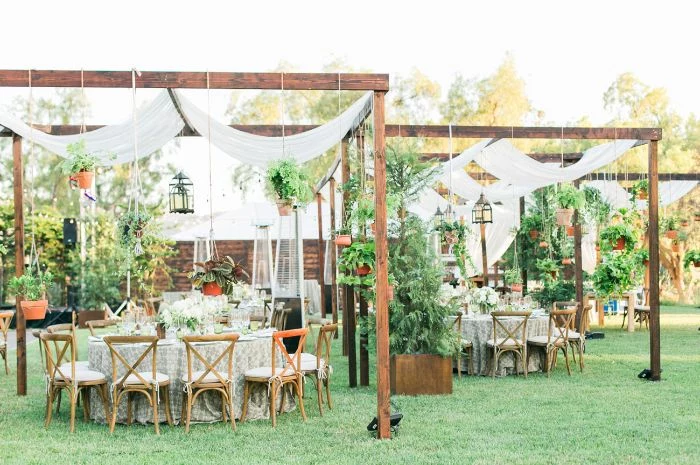
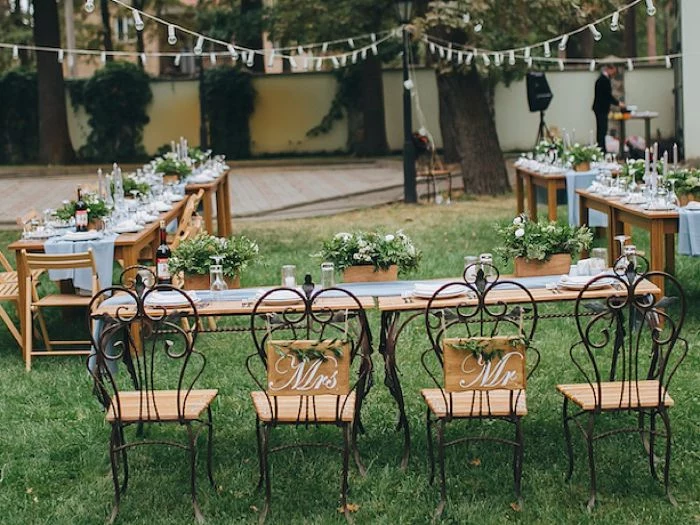
At a standard venue, the staff-to-guest ratio is often 1:15. For a backyard wedding, caterers may recommend 1:10 or even 1:8.
Why the increase? Because everything takes longer. Staff have to carry every plate, glass, and chair over greater distances and uneven terrain, often from a catering tent parked far from the tables. Proper staffing is key to service that feels effortless.
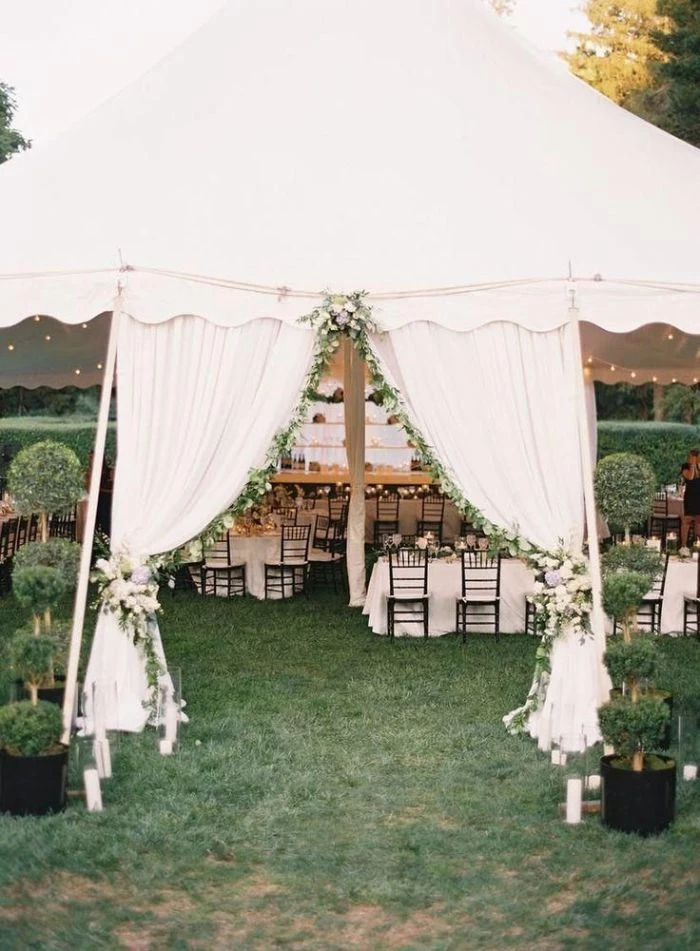
Can our Golden Retriever be the ring bearer?
Absolutely, but it requires a plan. Designate a dedicated ‘dog handler’ (not someone in the wedding party) who is responsible for your pet for the entire day—walks, water, and taking them inside when they get overstimulated. A trial run of them walking down the ‘aisle’ with the music and crowd is a very good idea!
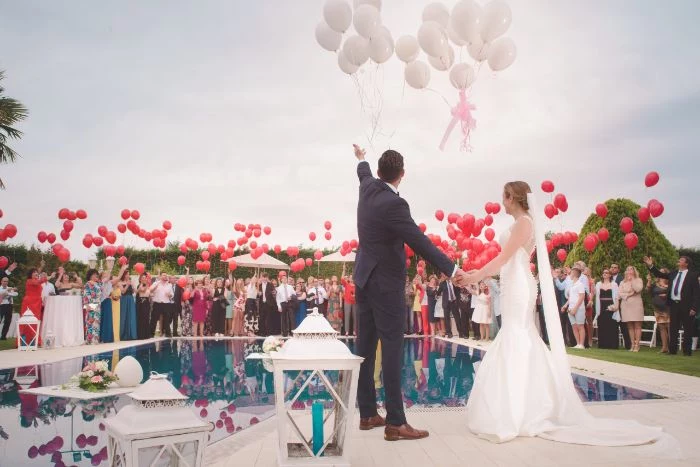
Your beautiful green lawn is the star of the show. To ensure it looks its best, start a targeted care plan at least two months out. This includes professional aeration to handle compaction from foot traffic, a fertilization schedule, and a plan for filling in any bare patches. On the day of, give it a final mow two days prior—not the day before, to avoid green stains on dresses.
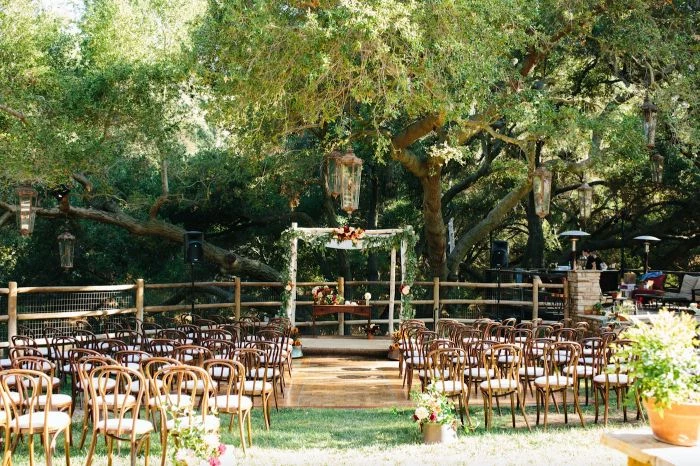
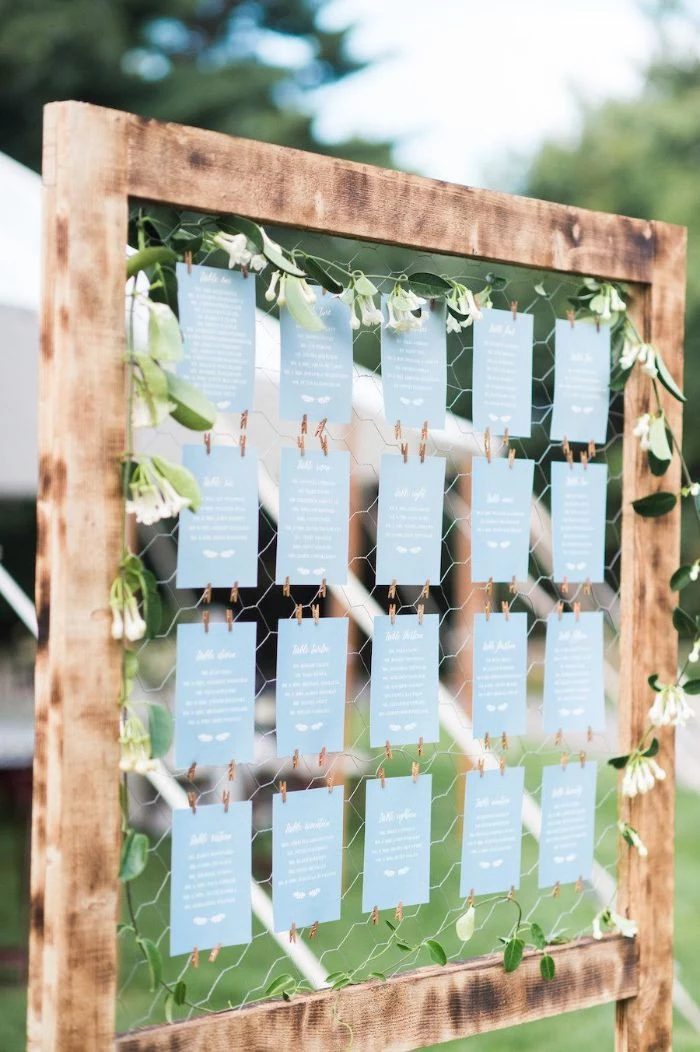
Sound is tricky in the open air. Wind can carry it away, and without walls to bounce off, you need a different strategy. Instead of two huge speakers at the front, a better setup often involves four or six smaller speakers distributed around the perimeter of the space. This provides even, pleasant coverage for both dinner music and heartfelt toasts without deafening the people sitting closest.
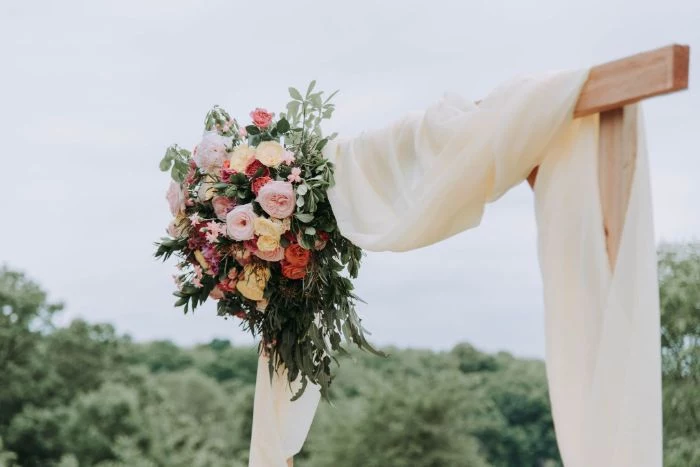
- Rental delivery and pickup fees (often hundreds of dollars).
- Permits (noise, tents, electrical) required by your town.
- Trash and recycling hauling service for the day after.
- Sales tax on every single rental item and service.
These ‘unglamorous’ costs can add up to thousands. Build a 15% contingency fund into your budget from day one to cover them.
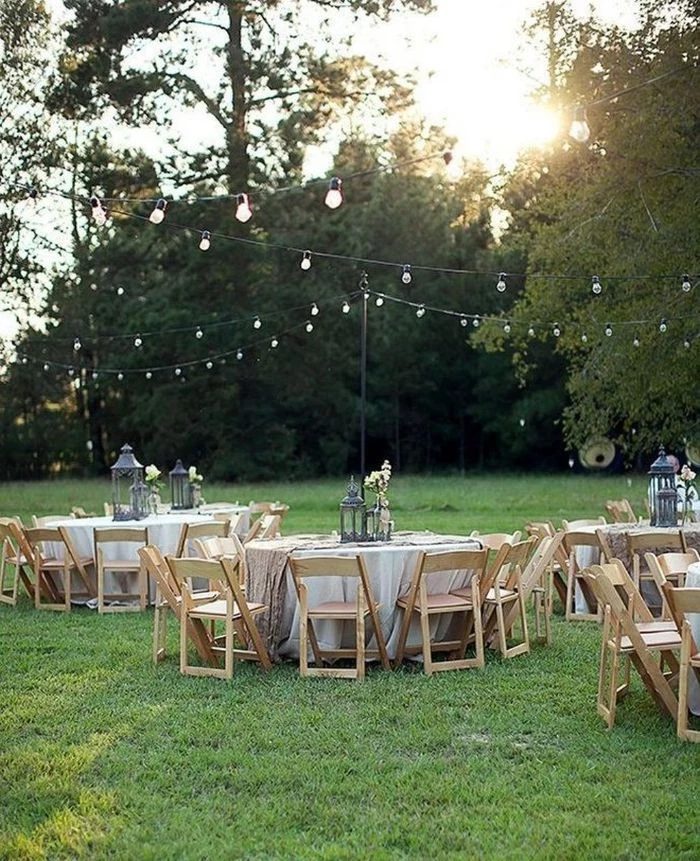

One of the biggest mistakes: Not planning for teardown. The party might end at 11 PM, but the rental company may not pick up the tent, tables, and flooring for a day or two. Clarify the exact pickup schedule with every single vendor. You need to know how long your backyard will remain a construction zone after the wedding is over.
Where does the grand exit happen? A sparkler send-off is beautiful, but it needs to end somewhere. Plan a clear pathway leading to a designated ‘getaway’ car at the end of the driveway, or have the path lead back towards the house for a final wave before the couple disappears inside for the night. The key is to choreograph the end moment just as carefully as the ceremony.



